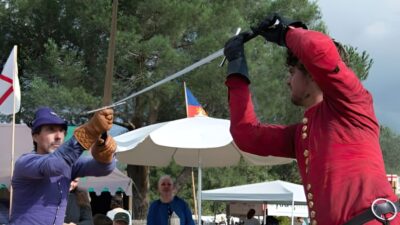Grosse Messer vs Katana: Differences & the Superior Dueling Blade
NO AI USED This Article has been written and edited by our team with no help of the AI
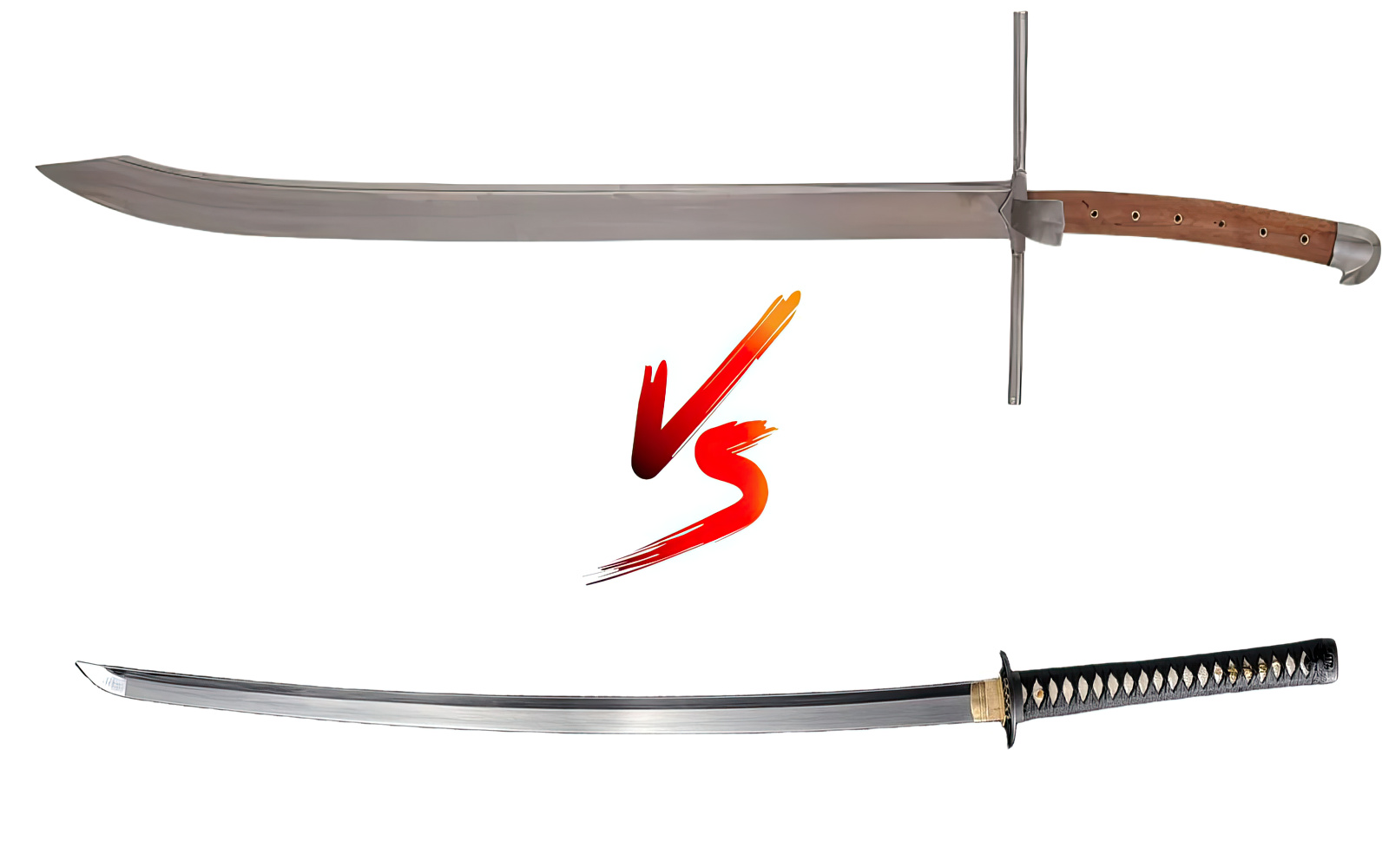
The Grosse Messer and katana are very similar swords in design. Originating from Europe and Japan respectively around the same time, the Grosse Messer is often overlooked due to the comparison between the Katana and Longsword. In this article, we explore the characteristics of both swords, their differences, histories, roles in warfare, and more.
Terms, Characteristics, and Design Differences
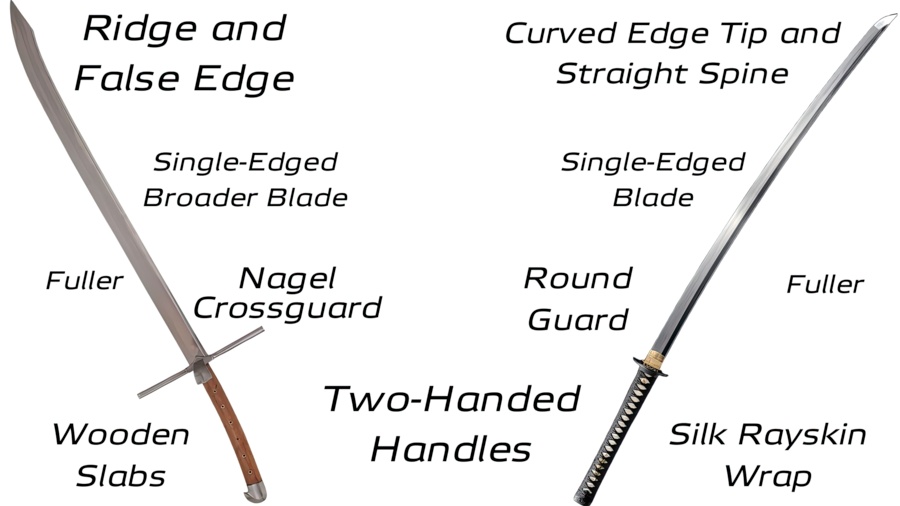
The messer is a type of European sword with a name that translates to “knife” in German. For example:
- Langes messer – Translating to big knife, it refers to single-edged medieval knives made larger to adapt to combat and martial arts. Available in a variety of shapes and sizes, it is reserved for the one-handed sword version.
- Grosse messer – Translating to “long knife” or “great knife”, this can be a hand-and-a-half variant.
- Kriegsmesser – A name that means war knife, it is a term that refers to the two-handed variant.
In Japanese, “katana” roughly translates to “sword”. It refers to the two-handed Japanese sidearm used by the samurai, carried with its edge pointing up when sheathed.
Blade
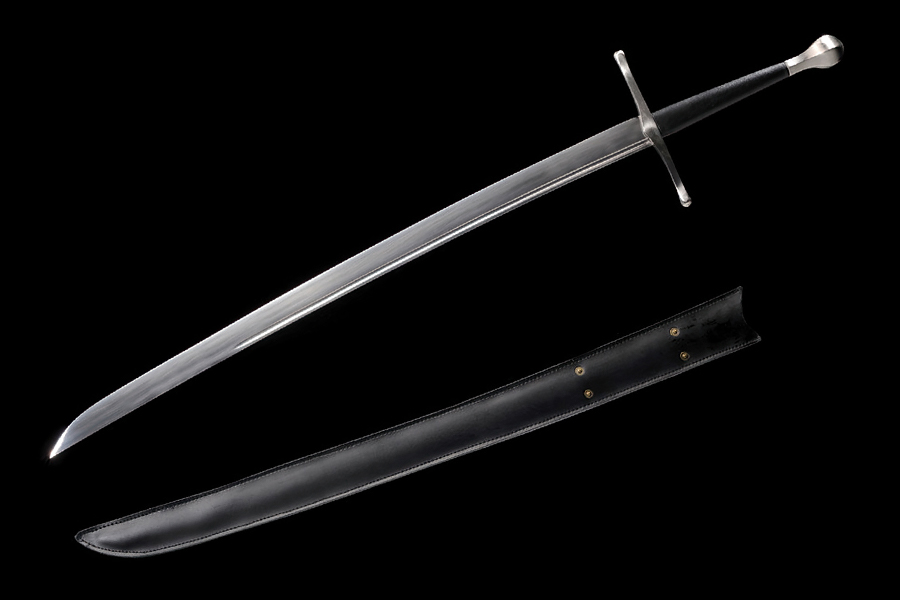
Both the grosse messer and the katana have high carbon steel blades. Comparing the two, the grosse messer is slightly broader in profile with some reaching 2 inches (5 cm) wide. It can come with a fuller near its unsharpened spine to decrease its weight and improve its point of balance.
Some of these blades can be straight and feature a ridge near its tip with a false edge (sharpened on both sides). The blade length of a messer can vary in length, but averages around 24 to 35 inches (60 to 90 cm) long.
A traditionally made Japanese katana sword is made from tamahagane, a type of folded steel. With slightly curved single-edged blades that are narrower than those of the messer, the katana is highly complex as different blade profiles (zukuri) are available.
Like the messer, the blades can feature grooves (bohi) to decrease their weight, improve their point of balance, and produce a better tachikaze (a whistling sound when a proper cut is made along the relative cutting plane. Although ranging around 24 to 31 inches (60 to 80 cm), katana blades can vary in length and come in longer (o-katana) or shorter (ko-katana) variants.
Hilt
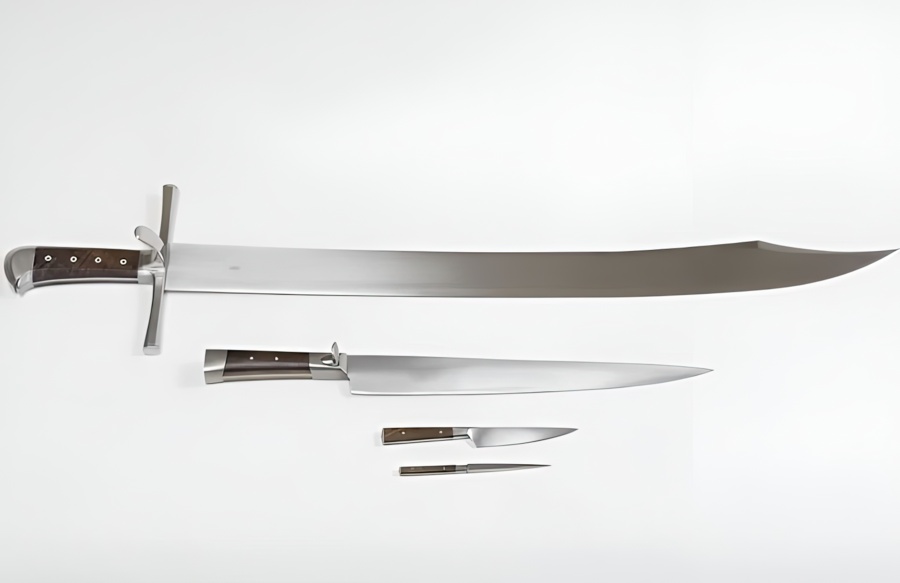
The European grosse messer is a hand-and-a-half or two-handed weapon with a slab tang visible on its handle. The handle is usually double-riveted and consists of two wooden slabs on each side. Instead of a traditional sword pommel, the grosse messer has a metal rounded “hat-shape” cap or curved “bird peak” pommel that allows for more versatile grips.
Messers feature the iconic nagel (nail), a metal extension mounted on a cruciform crossguard to protect the user’s hand without restricting movement while allowing for different combinations of attack. Some messers also have a recurved quillon or a knuckle guard.
Samurai katana swords are two-handed weapons. The full tang of the blade is inserted between the two wooden halves of the handle that are bonded together using sokui (rice glue) and further secured with mekugi (pegs). This allows for the handle to be disassembled without damaging any part of the sword. Katana swords are often equipped with handguards (tsuba) of varying shapes to protect the user’s hand from attacks.
For a firm grip, the wooden handle is first covered with rough rayskin (samegawa) and wrapped tightly with handle cord (tsuka ito) that is usually made from silk, cotton, or leather. Their pommel (kashira) is a small metal piece with eyelets (shitodome), allowing the cross binding of the handle cord (tsuka–ito) to pass through.
Scabbard
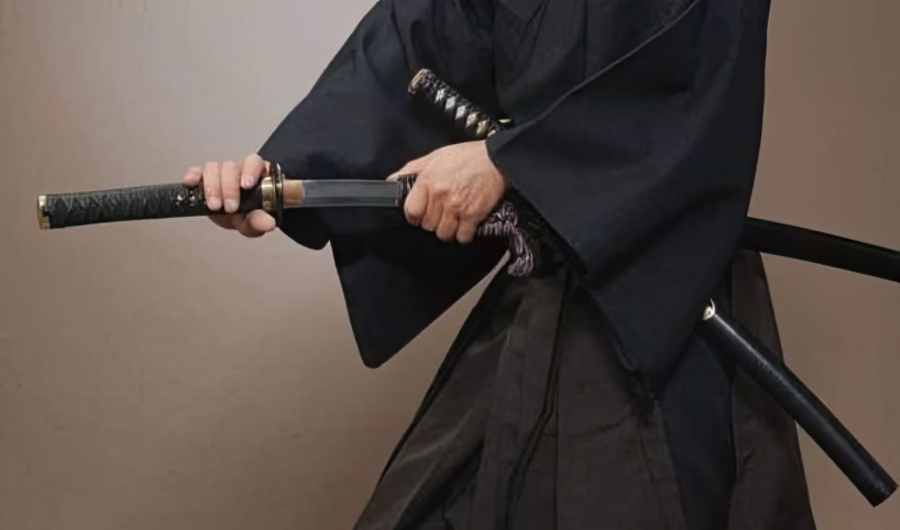
The grosse messer swords are traditionally carried on the left side of the waist, strapped to the user’s belt or hanging from an iron ring. The grosse messer may be encased in a scabbard made out of wood for better outer protection or a leather sheath.
The katana swords also have wooden scabbards (saya). There are two types of scabbards: the jindachi zukuri and the shirasaya. The jindachi zukuri scabbard has a greater emphasis on aesthetics and comes with a kurigata, a small knob to attach the sageo, a carrying cord so it can be secured to the wielder’s obi (belt). The katana in its scabbard is carried on the user’s left with its edge pointing upwards.
The second type of scabbard, the shirasaya, has an all-wood construction for maximum protection. Its name, translating to “white scabbard’ denotes its simplicity as it does not come with any mountings and is generally used for safe storage of the katana.
Size and Weight
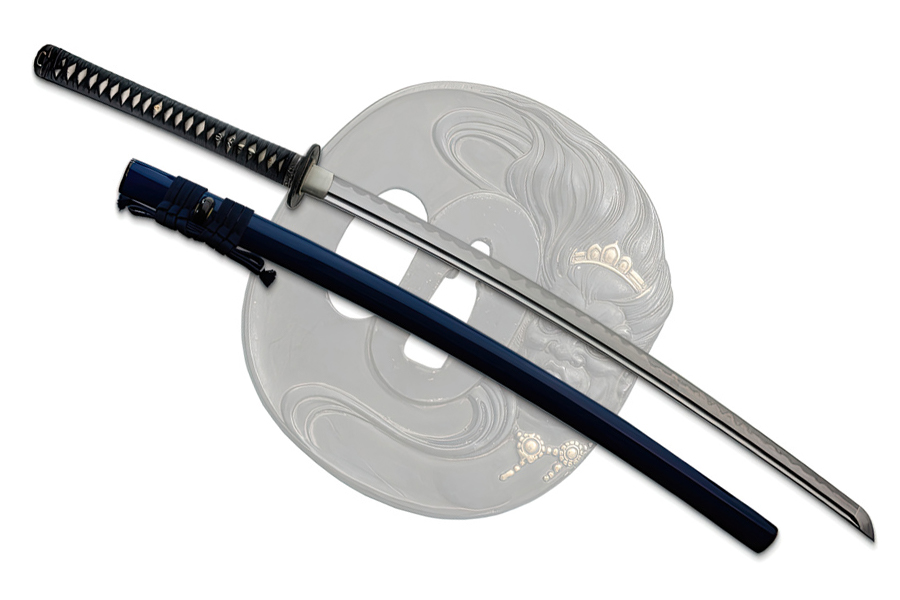
The European messer and Japanese katana are similar in length with the messer being slightly longer with a broader blade profile.
However, the grosse messer varies in length, ranging from a short sword to a much longer primary war sword. On average, the overall length of a grosse messer is around 30 to 51 inches (76 to 130 cm) and weighs about 1.76 to 2.86 lbs (0.8 to 1.3 kg).
Although Katana swords can vary in length depending on the historical period, the Edo Period (1603-1868) saw the standardization of the katana’s length, a definition that remains today. The overall length of a Japanese katana is 33.4 – 43 inches (85 – 109 cm) with a weight around 1.98 – 2.64 lbs (0.9 – 1.2 kg).
Historical Significance
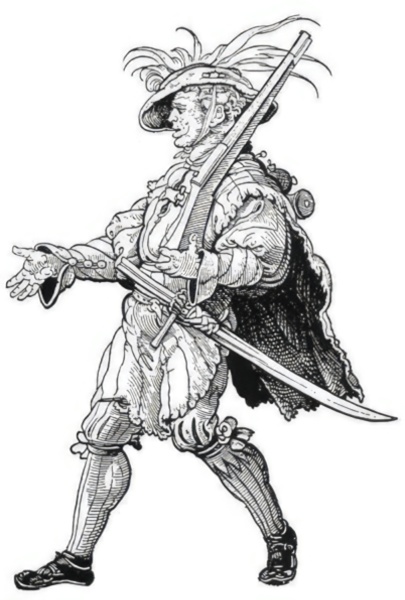
The grosse messer is a sword that first originated in the Holy Roman Empire, today’s south Germany and north Austria, with the earliest versions emerging as early as the 13th century. With a design based on Viking swords or arming swords, its blade is believed to have been inspired by eastern single edge sabers or an independently crafted cheaper knife with a larger blade, the seax.
Due to its popularity for everyday use, it became one of the most beloved blades used by both nobles and soldiers. From the 14th to the 16th century, it became a very popular dueling sword. In fact, it was one of the most popular medieval swords in martial arts besides the longsword. However, it was eventually replaced by the rapier, and later, the sabre. Today, the messer is used in Historical European Martial Arts (HEMA) training.
For the katana, it originated in Japan during the Muromachi period (1336-1576). It featured a shorter and less curved blade compared to its predecessor, the tachi, to be more practical and reliable for foot combat. Unlike the tachi which was carried with its edge down, the katana was carried edge up to allow the act of drawing the sword to double as a strike.
The katana’s superiority in close-quarter combat resulted in it quickly becoming the main sidearm of many samurai swordsmen. During the peaceful Edo Period (1603-1868), the katana became a work of art. It remained relevant in the Japanese community and was even partially used in battle during the 20th century. Today, the katana is still used in Japanese sword martial arts such as kendo and iaido.
Combat Preference
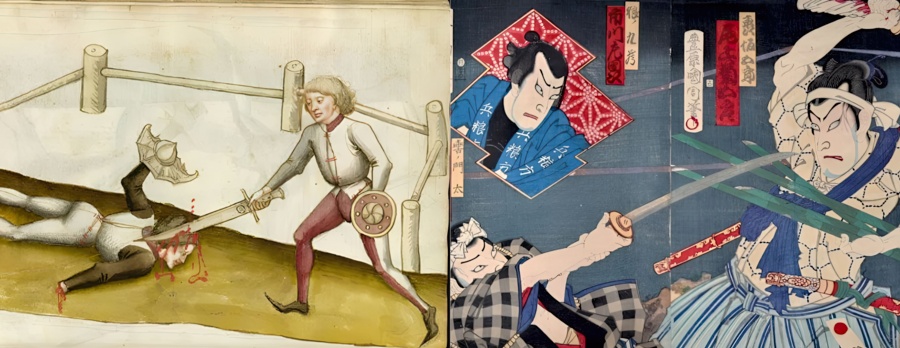
The grosse messer and katana are similar in design yet different in function. Both single-edged swords that prioritize cutting with some potential for thrusting, the grosse messer can be used with one or two hands, depending on its type. Its beak, pommel, and open guard gives its user versatility in terms of offense and defense.
The larger crossguard and nagel not only provides its user much protection, but can also be used for attacks. The tapering blade also ensures better precision and speed. Additionally, the false edge and ridge at the blade’s tip is great for “half-sword” techniques, where one grabs the blade and uses it as a dagger.
The katana has a single-edged blade that maintains its thickness from the base of the blade to the tip. Based on its design, the katana’s edge allows for easy blade edge alignment. Although its guard offers limited protection to the user’s hand, its open handle allows for a very firm grip. It has a slightly shorter blade length than the messer, making it a great sidearm as it is highly reliable in close-quarters combat, on foot, or even on horseback.
